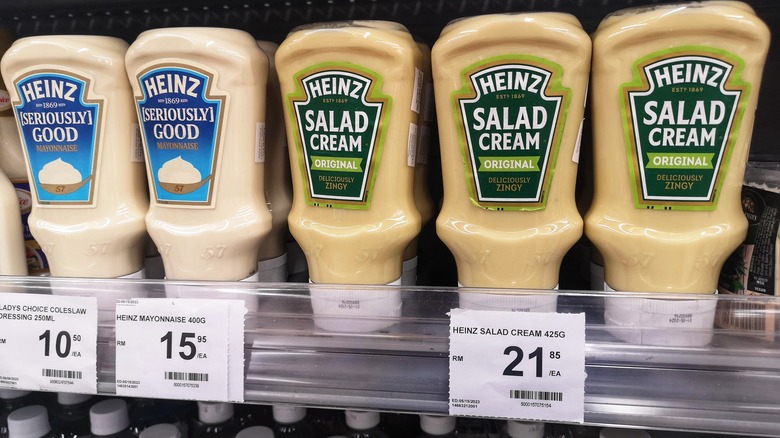Salad Cream Vs Mayo: What Is The Difference?
Many common British food terms are unfamiliar on this side of the pond, but have clear American counterparts. Crisps are chips, chips are fries, aubergine is eggplant, jacket potatoes are baked potatoes. Salad cream, however, has no true American equivalent. A favorite sandwich spread and all-purpose dressing for many Brits, salad cream is most often compared to mayonnaise. It's true that both are creamy, pale yellow condiments containing egg yolks, but there are a few key differences that set these spreads apart.
Mayonnaise usually consists of at least 70% and up to 80% oil, whereas salad cream typically contains a significant amount of vinegar and less than 50% oil. As a result, salad cream is much thinner, lighter, and tangier than mayonnaise.
Another key difference is that salad cream (true to its name) sometimes gets added richness from cream or milk, while mayonnaise does not traditionally contain dairy. Nowadays, mass-produced salad cream usually forgoes real dairy in favor of vegetable oil, but homemade versions often call for milk or cream.
The history of salad cream
Like most foods, the exact origins of salad cream are unclear, but the tangy boiled dressing likely originated in 19th-century Britain. The first mass-produced salad cream was debuted by Heinz in 1914. It gained widespread popularity during World War I because it was cheaper and more accessible than mayonnaise. Over a century later, Heinz remains the most popular British salad cream brand. The Heinz recipe includes spirit vinegar (the British equivalent of distilled vinegar), water, vegetable oil, sugar, and mustard.
Salad cream has developed a somewhat mixed reputation in the U.K. over the years, with some considering it subpar to richer, milder mayonnaise. Salad cream devotees, on the other hand, argue that mayonnaise is bland and boring compared to their beloved vinegary spread.
Although it originated in Britain, salad cream is now popular across the globe. In Thailand, it's a common dipping sauce and is used in a variety of dishes such as fried shrimp salad. It's also an essential component in many classic Nigerian salads and is beloved in New Zealand and Australia.
How to use salad cream
Heinz is the most popular mass-produced brand, but many people prefer to make their salad cream at home. Whether store-bought or homemade, it's usually seasoned with some combination of lemon juice, mustard, sugar, salt, and pepper, and pairs well with a wide variety of foods.
In the U.K., salad cream is commonly used as a sandwich spread, salad dressing, or meat marinade. More chaotically, it can be paired with cold baked beans or pizza (To me, this seems like the British version of putting ranch on pizza). Brits also like to combine salad cream and ketchup to make a zippy sauce for prawn cocktail (known as shrimp cocktail stateside).
Salad cream is not widely available in the U.S., where mayonnaise has a cult following, but can be found in specialty stores or online. So if you're tired of bland mayonnaise and looking for a condiment with a little more zing, consider salad cream.


